
Selecting the proper sprayer nozzle type is essential for proper pesticide application. The nozzle is a major factor in:
- Determining the amount of spray applied
- Uniform application
- Coverage reaching its target surface
Nozzles break the liquid into droplets, form the spray pattern, and propel the droplets in the proper direction. They also determine the amount of spray volume at a given operating pressure, travel speed and spacing. Drift can be minimized by selecting nozzles that produce the largest droplet size while providing adequate coverage at the intended application rate and pressure.
We want to help you find the perfect nozzle for your application, so we’ve researched each type to give you a better idea about the pros, cons and overall differences.
Best Sprayer Nozzles for Applying Herbicides
- Flat-Fan Sprayer Nozzles (Even, Twin-Orifice, Off-Center, Air-Induction)
- Flood Sprayer Nozzles
- Hollow-Cone
- Full-Cone
Download our Nozzle Selection 101 Cheat Sheet
Even Flat-Fan Sprayer Nozzle
“Even flat-fan nozzles are utilized in banding applications (as opposed to broadcast spraying),” said TeeJet Technologies Manufacturer Representative, Bryan Fowler. “These tips will deliver an equal amount of spray across the entire width of the spray pattern to ensure even distribution.”
These nozzles do not produce a tapered edge and do not require overlap. The nozzle height and the spray angle both control the spray pattern width. Extended range flat-fan nozzles are designed to work under a much larger range of pressure compared to a regular flat-fan nozzle. This nozzle is recommended for the grower who is looking for uniform distribution and wants more drift control at lower pressures.
“We’ve recommended growers use the TurboDrop Venturi in combination with even flat-fan nozzles for over 20 years to provide a low-drift version of the even flat-fan,” said Greenleaf Technologies Regional Sales Manager, William Smart. “When combining the two, the even flat-fan should be double the size of the TurboDrop Venturi. The Venturi will control the flow rate, and the larger pattern tip will allow the air injection to work properly.”
Twin-Orifice Flat-Fan Sprayer Nozzle
Twin-orifice flat-fan nozzles produce two spray patterns with one orifice angled 30 degrees forward and the other orifice angled 30 degrees backward. This nozzle is noted for spraying smaller droplets in both spray patterns providing more penetration and coverage.
“Twin pattern tips are designed to deliver two inline patterns, roughly 60 degrees apart,” Fowler said. “This enables the spray to approach the surface area of the target from two angles and improve the chances of thorough coverage.”
Off-Center Flat-Fan Sprayer Nozzle
Another new fan design is the off-center fan, which is used for boom-end nozzles so the swath is uniform from end-to-end and not tapered at the edges.
“The off-center (OC) nozzle will distribute the spray laterally, away from the end of the boom,” Fowler said. “This will help it to reach an area beyond the length of the boom. This could be used as a boom-end nozzle, delivering herbicide to spray fence rows or ditches.”
“Off-center nozzles are also often used in orchards and vineyards to spray along the tree trunk line or strip spray under a grape vine,” Smart said. “This is another situation where using Greenleaf Tech Venturis to convert conventional off-center nozzles to air-injected OC nozzles would help prevent drift from affecting trees and vines or prevent overspray along a fence row.”
Air-Induction Flat-Fan Sprayer Nozzle
The air-induction nozzle is noted for producing large drops through the use of a venturi air aspirator. The venturi draws the air into the nozzle, and then the air is mixed with the solution to create larger spray droplets, which reduces drift potential.
“Air-induction (AI) spray tips are ideal for situations that involve spraying solutions that have little tolerance for drift,” Fowler said. “Typically, this will involve herbicides that could possibly harm non-target plants. Although air induction spray tips vary in style and pattern, the primary characteristic is that they have a greatly reduced quantity of drift prone droplets compared to the non-AI versions of the same tip. Many are available in both single and twin patterns.”
Why Flat Fan Sprayer Nozzles Are the Best for Applying Herbicide
Flood Sprayer Nozzle
Flood nozzles are similar to full-cone nozzles in that they produce large droplets and their ideal overlap is 100 percent. The flood nozzle produces a spray pattern that is similar to the even flat-fan nozzle but emits larger droplets.
“Flood style tips have large open passages and will not easily plug,” Fowler said. “Many times, this tip is utilized as a pre-emerge application tip. The large droplets are very good for soil applied products in broadcast applications.”
Hollow-Cone Sprayer Nozzle
Hollow cone nozzles provide more complete coverage of plants due to the smaller droplets it emits. Looking at the spray pattern, the hollow cone is formed by a circular orifice that creates a cone shape pattern with an open center.
“This style of tip is typically utilized in fruit and vegetable spraying,” Fowler said. “In these applications, insecticide and fungicide application are very common and the requirement for thorough coverage dictates the need for smaller droplets. These applications are either directed over the top and sides of the target (vegetables) or sprayed into a wind current to carry the spray into the canopy; this would be typical of an air blast sprayer in fruit trees.”
“Hollow cones are often misused in broadcast applications,” Smart said. “They were designed for spraying over the row in combinations of two to three nozzles. They can also be used for banding applications like an even flat-fan.”
Full-Cone Sprayer Nozzle
The full-cone nozzle utilizes the same circular-shaped orifice as the hollow cone except this nozzle produces output through the entire cone spray pattern, as opposed to the hollow cone. The full-cone nozzle produces
larger droplets making this nozzle more drift resistant.
“Full-cone nozzles are frequently used in tobacco spraying,” Fowler said. “This is typically for applying chemicals in a directed pattern for sucker control. The full-cone nozzle creates a coarse spray over the top of the plant so that it will run down the plant to the buds.”
Check out our white paper for more information about nozzle selection or contact your local Apache Sprayer Dealer.


